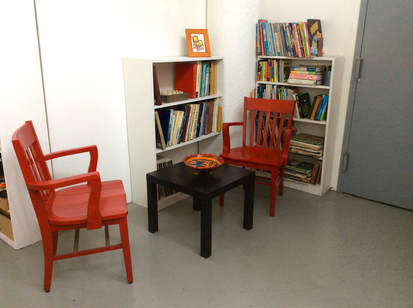My studio is in a 1930's art deco building in Long Island City, just across the East River
from my home in the Murray Hill neighborhood in New York City.
Here's the view from the roof. It was originally Helena Rubenstein's makeup factory,
and now about three dozen artists have their studios in the building.
from my home in the Murray Hill neighborhood in New York City.
Here's the view from the roof. It was originally Helena Rubenstein's makeup factory,
and now about three dozen artists have their studios in the building.
Here's the front of the building. My studio is on the left side.
Come in to the studio... (second studio to right, behind bookcases).
Here's where I create my books (cleaned it up for the photos!) , write, do the illustrations.
For gallery exhibitions, I also work on oils, watercolors, and art for prints here.
I have the only skylight in the building - great for bright even light.
For gallery exhibitions, I also work on oils, watercolors, and art for prints here.
I have the only skylight in the building - great for bright even light.
After making a book dummy (a B&W mock-up of the book with each page sketched in)
and getting an okay from my editor, I draw the illustrations loosely in pencil on plain paper,
with as many iterations of each spread as needed, to get it right.
Everything in the composition is carefully researched and worked out.
Then, I put the final sketch under a sheet of good paper on a light table, and work in pencil .
Next, I draw, in ink, the entire piece of art (in this photo).
After that I start the painting - putting in the shadows (the underpainting,
usually blue-green and lavender), and then, the most fun, paint in all the color
(by this time, I have already done a lot of research on the subject).
When the art is finished, after a lot more study and a lot of rewriting,
I submit the final text to my publisher, which is vetted, edited, and proofread.
and getting an okay from my editor, I draw the illustrations loosely in pencil on plain paper,
with as many iterations of each spread as needed, to get it right.
Everything in the composition is carefully researched and worked out.
Then, I put the final sketch under a sheet of good paper on a light table, and work in pencil .
Next, I draw, in ink, the entire piece of art (in this photo).
After that I start the painting - putting in the shadows (the underpainting,
usually blue-green and lavender), and then, the most fun, paint in all the color
(by this time, I have already done a lot of research on the subject).
When the art is finished, after a lot more study and a lot of rewriting,
I submit the final text to my publisher, which is vetted, edited, and proofread.
Here I am drawing (inking) the original art (a huge maze, 3.5 feet x 5 feet) for
"Roxie's a-MAZE-ing Vacation Adventure" and
"Roxie's Puzzle Adventure" interactive game apps.
I am working on top of my big center table -
the paper for the giant maze is mounted on cardboard.
It's too big to work on at my regular drawing tables (behind).
"Roxie's a-MAZE-ing Vacation Adventure" and
"Roxie's Puzzle Adventure" interactive game apps.
I am working on top of my big center table -
the paper for the giant maze is mounted on cardboard.
It's too big to work on at my regular drawing tables (behind).
Here's the finished maze art, rolled up, and the app on the iPad.
Working on preliminary sketches/layouts for "Market Maze." As a Visual Thinker, I conceive of the book idea, do a lot of the preliminary research, and then the dummy.
I often write the text and do the rest of the research AFTER the visuals are worked out.
That's kind of opposite the way most editors like to work -
they usually want the text first.
I often write the text and do the rest of the research AFTER the visuals are worked out.
That's kind of opposite the way most editors like to work -
they usually want the text first.
Got a new iMac recently!
Here's my art library, office supplies...
A light table is hidden behind white bookcase on the right, along with book stock.
Reception area, with art books and children's books.











